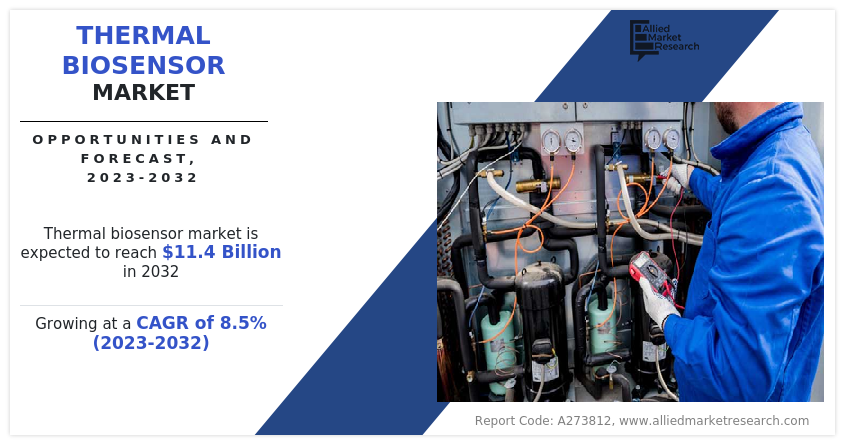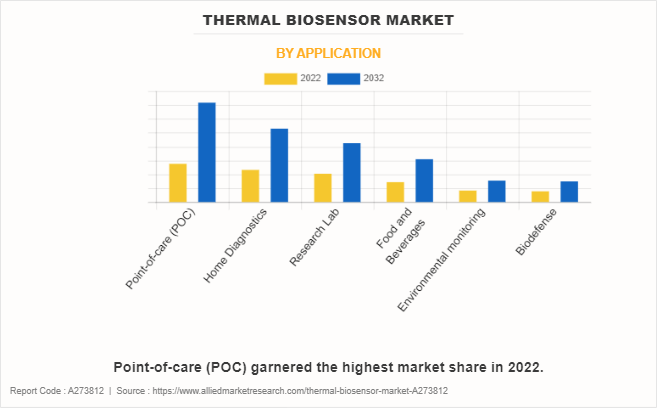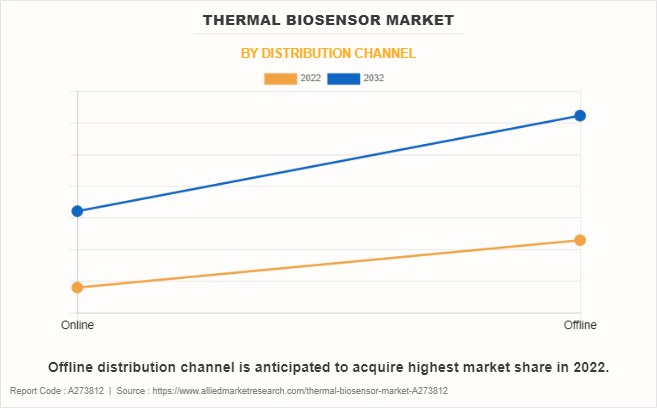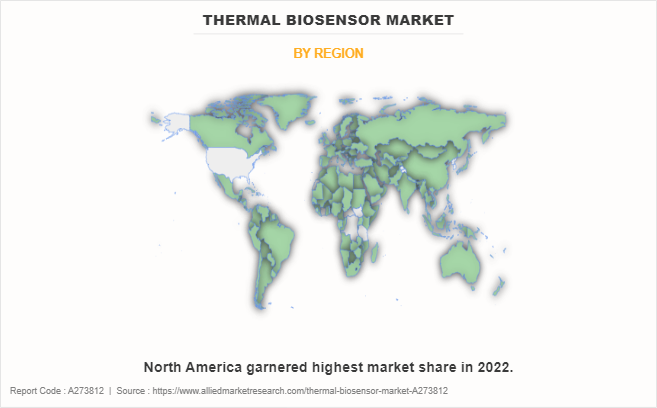Thermal Biosensor Market Research, 2032
The Global Thermal Biosensor Market was valued at $5.1 billion in 2022 and is projected to reach $11.4 billion by 2032, growing at a CAGR of 8.5% from 2023 to 2032. A thermal biosensor is a specialized type of biosensor that operates by identifying alterations in temperature resulting from biological interactions or processes. These sensors are engineered to convert the thermal signal produced by a biochemical reaction into a measurable electrical signal, providing crucial insights into the presence, concentration, or attributes of specific biological molecules. They have wide-ranging applications in fields such as medical diagnostics, environmental monitoring, and food safety.
The fundamental principle of a thermal biosensor lies in its capacity to transform thermal alterations into a quantifiable signal. Typically, these sensors comprise a transducer component, frequently a thermistor or microcalorimeter, situated near a biological recognition element. This recognition element is often a bioreceptor, like an enzyme, antibody, or DNA/RNA sequence, which selectively interacts with the targeted biomolecule. When the bioreceptor binds to its target, it induces a thermal effect, either releasing heat (exothermic) or absorbing it (endothermic). This shift in temperature is then picked up by the transducer and converted into an electrical signal proportional to the extent of the thermal shift.

Segment Overview
The market is segmented into application and distribution channels.
A prominent advantage of thermal biosensors is their exceptional sensitivity and specificity. They can discern minute temperature changes, enabling precise quantification of target molecules even at extremely low concentrations. Furthermore, they are less susceptible to interference from other components in complex biological samples, a challenge often encountered by some other biosensor types. These attributes render thermal biosensors especially valuable in fields like clinical diagnostics, where the accurate identification of biomarkers is pivotal for disease diagnosis and monitoring.
On the basis of application, the market is bifurcated into point-of-care (POC), home diagnostics, research lab, food and beverages, environmental monitoring, and biodefense. In 2022, the above point-of-care (POC) segment dominated the thermal biosensor industry, and it is expected to acquire a major market share by 2032.

On the basis of distribution channels, the market is bifurcated into online and offline. In 2022, the above offline segment dominated the market, and the online segment is expected to acquire a major market share by 2032.

Based on region, the thermal biosensor market trends are analyzed across North America (the U.S., Canada, and Mexico), Europe (the UK, Germany, France, and the rest of Europe), Asia-Pacific (China, Japan, India, South Korea, and rest of Asia-Pacific), and LAMEA (Latin America, Middle East, and Africa).

Region Analysis
Country-wise, the U.S. acquired a prime share in the market in the North American region, and it is expected to grow at a significant CAGR during the forecast period of 2023-2032.
In Europe, the UK dominated the Thermal biosensor market share in terms of revenue in 2022 and is expected to follow the same trend during the forecast period. However, Germany is expected to emerge as the fastest-growing country in Europe's market with a CAGR of 9.2%.
In the Asia-Pacific region, China is expected to emerge as a significant market for the thermal biosensor market industry, owing to a significant rise in investment by prime players due to the increase in the use of smartwatches, which provide the temperature of the skin to all connected devices.
In the LAMEA region, the Middle East garnered a significant market share in 2022. The LAMEA thermal biosensor market has witnessed an improvement, owing to the growth in the inclination of prime vendors towards utilizing the thermal biosensor across this region in healthcare systems. Moreover, the Latin America region is expected to grow at a high CAGR of 7.9% from 2023 to 2032.
Historical Data & Information
The global Thermal biosensor market is highly competitive, owing to the strong presence of existing vendors. Vendors of the market with extensive technical and financial resources are expected to gain a competitive advantage over their competitors because they can cater to market demands. The competitive environment in this market is expected to worsen as technological innovations, product extensions, and different strategies adopted by key vendors increase.
Key Developments/ Strategies
DowDupont Inc., LifeSignals, Nova Biomedical Corporation, Masimo Corporation, Siemens, Fitbit (Google), Garmin, and TA Instruments are the top companies holding a prime share in the market. Top market players have adopted various strategies, such as product launch, new product development, collaboration, and upgradation to expand their foothold in the Thermal biosensor market.
- In April 2023, Masimo announced that the Rad-G with Temperature has received FDA 510(k) clearance. Rad-G with Temperature is a rugged, versatile, handheld monitor that provides clinically proven SET pulse oximetry, thermal detection biosensor, respiration rate from the pleth (RRp), and other important parameters alongside non-contact infrared clinical thermometry.
- In March 2023, Waters Corporation announced a new Battery Cycler Microcalorimeter Solution from its TA Instruments division for the high-resolution characterization of battery cells. The instrument and software combination enables non-destructive testing under real-world operating conditions and significantly reduces experiment time from months to weeks while providing decisive insights for greater battery efficiency, safety, and stability.
- In January 2022, Cardea Bio, Inc., the world's only mass producer of biocompatible semiconductors, announced a collaboration agreement with Siemens Healthineers' Center for Innovation in Diagnostics (CID) to assess the feasibility of developing real-time biosensor applications using Cardea's BPU (Biosignal Processing Unit) Platform.
- In August 2022, Fitbit (Google) announced the launch of Versa 4 and Sense 2 smartwatch which consists of 24/7 heart rate monitoring and activity tracking to real-time stats, walk/run detection on your wrist, skin temperature, sleep tracking, and stress tracking.
- In March 2022, Nova Biomedical Corporation developed a cost-effective biosensor for detecting various conditions happening in the body during COVID-19.
- In June 2021, Waters Corporation announced the development of TRIOS AutoPilot software from its TA Instruments division for its thermal analyzer product line. The software helps laboratory staff using TA’s thermal analyzers create routine and streamlined standard operating procedures (SOPs) up to 25% faster and avoid transcription errors that can inhibit productivity and can lead to inconsistent thermal analysis measurements that are used to assess materials performance as well as batch-to-batch product quality.
- In April 2020, LifeSignals Group Inc. announced that a single-use, wireless biosensor for the early detection and monitoring of coronavirus symptoms was being fast-tracked for introduction within weeks. Based on a proven platform for cardiovascular monitoring, the Biosensor 1AX, simply affixed on the chest area, will record temperature, respiration rate, ECG trace, heart rate, and movement in real-time in the thermal biosensor industry.
Key Benefits For Stakeholders
- This report provides a quantitative analysis of the market segments, current trends, estimations, and dynamics of the thermal biosensor market from 2022 to 2032 to identify the prevailing thermal biosensor market size.
- The market research is offered along with information related to key drivers, restraints, and opportunities.
- Porter's five forces analysis highlights the potency of buyers and suppliers to enable stakeholders to make profit-oriented business decisions and strengthen their supplier-buyer network.
- An in-depth analysis of the thermal biosensor market segmentation assists in determining the prevailing thermal biosensor market growth.
- Major countries in each region are mapped according to their revenue contribution to the global market.
- Market player positioning facilitates benchmarking and provides a clear understanding of the present position of the market players.
- The report includes the analysis of the regional as well as global thermal biosensor market forecast, key players, thermal biosensor market overview, application areas, thermal biosensor market opportunity, and market growth strategies.
Thermal Biosensor Market Report Highlights
| Aspects | Details |
| Market Size By 2032 | USD 11.4 billion |
| Growth Rate | CAGR of 8.5% |
| Forecast period | 2022 - 2032 |
| Report Pages | 253 |
| By Application |
|
| By Distribution Channel |
|
| By Region |
|
| Key Market Players | Nova Biomedical Corporation, LifeSignals, Masimo Corporation, Garmin, TA Instruments, Fitbit (Google), Siemens, DowDupont Inc. |
Analyst Review
A thermal biosensor is a specialized form of biosensor designed to detect temperature changes arising from biological interactions or processes. It operates by converting the thermal signal produced by a biochemical reaction into a measurable electrical signal, yielding valuable insights into specific biological molecules' presence, concentration, or characteristics. These sensors have broad applications across diverse fields like medical diagnostics, environmental monitoring, and food safety.
The remarkable sensitivity and specificity of thermal biosensors render them highly valuable. Thermal biosensors can discern even the slightest temperature alterations, enabling precise measurement of target molecules at extremely low concentrations. This is particularly crucial in areas like clinical diagnostics, where accurate identification of biomarkers is essential for disease diagnosis and monitoring. Furthermore, thermal biosensors are less susceptible to interference from complex components in biological samples compared to certain other biosensor types. This robust performance has resulted in their widespread adoption in various applications.
The future outlook for thermal biosensors is promising. As technology advances, we anticipate further improvements in their sensitivity, specificity, and detection speed. This has the potential to revolutionize numerous industries, particularly healthcare, by enabling swifter and more accurate diagnoses. In addition, ongoing research is likely to lead to the creation of innovative bioreceptors and transducer elements, broadening the range of detectable biomolecules. The integration of emerging technologies like artificial intelligence and nanotechnology could further enhance their capabilities and extend their applications.
Moreover, the incorporation of thermal biosensors into wearable devices could revolutionize personal health monitoring. Envision a scenario where individuals can continuously monitor specific biomarkers, offering early indications of potential health concerns. This could lead to more proactive and tailored healthcare, ultimately improving patient outcomes. In addition, deploying thermal biosensors in environmental monitoring could lead to improved detection and management of pollutants and contaminants, contributing to a safer and healthier environment.
The upcoming trends in the Thermal Biosensor Market include a focus on point-of-care applications, integration with wearable devices, and increased utilization in environmental monitoring.
The leading application of the Thermal Biosensor Market is in medical diagnostics, driven by the demand for rapid and accurate real-time detection of biological molecules.
North America is the largest regional market for Thermal Biosensor.
The global thermal biosensor market was valued at $5,058.0 million in 2022.
DowDupont Inc., LifeSignals, Nova Biomedical Corporation, Masimo Corporation, Siemens, Fitbit (Google), Garmin, and TA Instruments.
Loading Table Of Content...
Loading Research Methodology...



